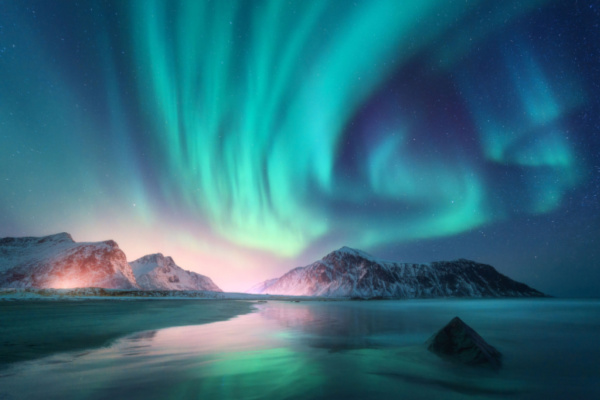If seeing the aurora borealis (northern lights) is on your bucket list, turn your attention skyward: experts say 2024 will be a sensational year for spotting the elusive light show.
As Lonely Planet reports, natural phenomenon is usually observable around the Arctic Circle – but this year, people across large swaths of the US and Europe might be able to see the ethereal display. Here is everything you need to know.
What is the aurora borealis (northern lights)?
“Auroras happen because charged particles from the sun interact with the Earth’s magnetic field,” says Dr. Shannon Schmoll, director of the Abrams Planetarium at Michigan State University. “This process excites gas atoms in our atmosphere that release light as they calm back down.” Different gasses result in various colors, setting the celestial stage for psychedelic ballets that might appear green, purple, blue, red, or yellow.
This phenomenon occurs in an area called the “auroral oval” or “auroral zone.” In the Northern Hemisphere, the region usually encompasses high latitudes like Alaska, Northern Canada, Russia, and the Nordics. But the zone shifts depending on the strength of solar storms, which release huge amounts of charged particles. Scientists predict the sun is on track for a stormy season.
What’s unique about the northern lights in 2024?
Based on current data, Dr. Schmoll says the sun will reach “solar maximum,” – the peak of an 11-year cycle when solar activity is greatest – sometime between 2024 and 2025.
The level of solar activity is currently the highest it’s been in about 20 years, when prolonged geomagnetic storms known as the Great Halloween Storms of 2003, made the northern lights visible as far south as Florida, Texas, and the Mediterranean. The biggest storm on record is still the Carrington Event in 1859. “It was strong enough for northern lights to be seen as far south as Mexico,” says Schmoll.
If the sun replicates this solar flare, Earth is in for a treat. But solar activity is erratic. There’s no light switch for the aurora borealis, and hopefuls in lower latitudes shouldn’t spend sleepless staring skyward.
A person sits by a calm lake at night, with the Northern Lights (aurora borealis) shimmering in the sky above, reflecting in the water, surrounded by silhouetted pine trees.
How to see the northern lights in 2024
Even if you join a top-dollar aurora expedition, there’s no guarantee you’ll see a solar show. But according to the National Oceanic and Atmospheric Association (NOAA), there are several things you can do to increase your chances.
Get out of the city
First, avoid bright lights. Shining cities will drown out the aurora, so your best bet is to find an International Dark Sky Park or Sanctuary with exceptionally inky skies. In the US, you could find luck at Montana’s Glacier National Park, Michigan’s Headlands International Dark Sky Park, or Maine’s Katahdin Woods and Waters National Monument. All are far enough north that this year’s solar storms might make a surprise appearance.
It’s also helpful to travel outside of a full moon. Consult the moon calendar 2024 and plan a trip when the moon is a crescent.
Go during the right season
It’s imperative to consider timing, too. Spotting the aurora is a night owl’s quest, with peak viewing usually between 10 pm and 2 am local time – though this changes seasonally. The best chances of spotting neon sky streaks occur near the spring and fall equinoxes (March and September) when solar winds tend to be strongest. In summer, the Arctic’s midnight sun will thwart your efforts.
Check the local weather
Spotting northern lights also calls for clear skies and a solar storm – though these circumstances are impossible to control. Consulting weather apps, like NOAA’s Space Weather Prediction Center website or the My Aurora Forecast and Alerts app, can help – but don’t expect 100% accuracy.
Visit the best locations
The most important factor (aside from plenty of patience) is location. “While seeing them farther south is more likely during solar maximum, heading north is always going to give you a better chance,” says Schmoll. You can cross your fingers for an aurora in Ireland and Idaho, but if you really want to see the phenomenon, start planning an Arctic adventure.
A lone figure stands on a black sandy beach at night, illuminated by a headlamp, with the majestic Northern Lights casting a green glow over the rugged mountain peaks in the background.
The northern lights over Stokksnes, Iceland © Posnov / Getty Images
The 9 best places to see the northern lights in 2024
Head north, and your likelihood increases. Iceland’s Westfjords, the country’s northernmost peninsula, experiences longer nights and less cloud cover than much of the country. There’s also little light pollution, thanks to tiny, secluded towns shadowed by steep fjords. For dark skies, head to Bolafjall – a 2086ft-high mountain feet above the peninsula’s unofficial capitol, Ísafjörður – where jet-black skies offer excellent odds of seeing neon streaks.
—
Photo Credit: Denis Belitsky / Shutterstock.com
